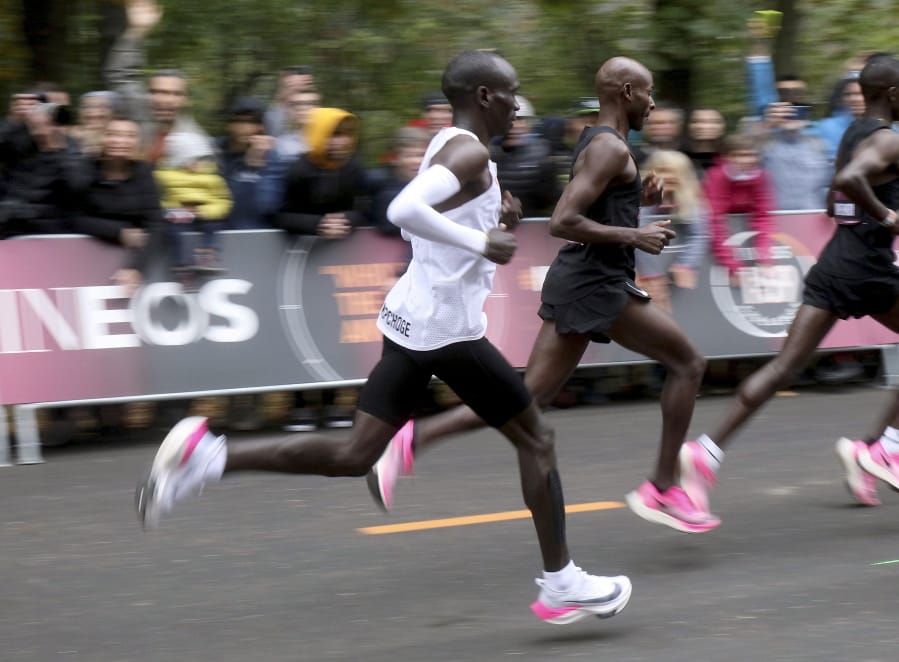To pick the favorites in this year’s Olympic marathon, just glance at the shoes of the runners on the starting line.
Anyone wearing Nike’s Vaporfly model may already have a head start.
The shoe has shaken up distance running since the world’s largest sports apparel company introduced it four years ago, with technology credited for helping runners shave minutes off their times. To some, the advances are an exciting revolution. Others have called it “technology doping” that risks reducing marathons to a shoe competition.
“Running is so simple. That’s why people love it so much. Now we have a shoe that is blurring that,” said Geoff Burns, a runner and Ph.D candidate at the University of Michigan’s School of Kinesiology.
The controversy prompted World Athletics, the sport’s governing body, to issue its most stringent shoe regulations in decades ahead of the Tokyo Games. But the Vaporfly escaped a ban, and the debate continues.
Now, Nike has a new racing shoe that also squeaks by the new rules: The Air Zoom Alphafly Next%, which was unveiled at a flashy fashion show in New York on Wednesday night. Eliud Kipchoge of Kenya wore a prototype of the shoe when he ran the world’s first sub-two-hour marathon in an unofficial race in October.
Kenya’s Brigid Kosgei was also in a version of the shoe when she set the world record for women in Chicago last year. Geoffrey Kamworor of Kenya wore a version of Vaporfly when he won the New York Marathon in November. All three of the men’s marathon medalists at the 2016 Rio Olympics laced up a version of the shoe as well.
Vaporfly shoes have become a common sight at marathons all over, easily spotted with their neon green or pink hue.
Many marathoners are gladly paying the $250 price tag on Nike’s website — and sometimes more — even as they wonder how much credit they can personally take for improved results.
Bryan Lam, an amateur marathoner in Washington, D.C. said he spent $400 for a pair of StockX ahead of the London Marathon last spring because the version he wanted was sold out elsewhere. He ran the marathon in 2:59.30, seven minutes faster than his previous personal best, a result he called “insane.” It helped him achieve his lifelong goal of qualifying for the Boston Marathon this year.
“I’d like to think that it was because of all of my training for the London Marathon but I do think the shoes had something to do with my performance,” Lam said. “It’s definitely not a level playing field when those who can afford the shoes have that type of advantage.”
What differentiates the Vaporfly is a foam midsole that is lighter and less dense than others, allowing for extra cushioning without adding weight. The shoe also has a carbon-fiber plate that acts like a lever to reduce the work at the ankle. Independent and company-sponsored studies have found that the shoe gives runners a 4 percent edge in energy efficiency.
The Air Zoom Alphafly Next% steps it up a notch with two “air pods” in the sole for extra cushioning. Both the Vaporfly and the Alphafly meet a World Athletic rule that limits the sole thickness to no more than 40 millimeters. The Alphafly will be available for sale to Nike members starting Feb. 29, meaning it meets a new rule that shoes must be available on the open market by April 30 to be allowed at the Tokyo Games.
Kyle Barnes, an exercise science assistant professor at Grand Valley State University in Michigan, conducted a study around two years ago that compared the Vaporfly shoes to Nike’s Zoom Matumbo 3 (a track spike) and Adidas Adizero Adios 3. His findings showed about 4.2 percent more efficiency by wearing the Vaporfly model.



